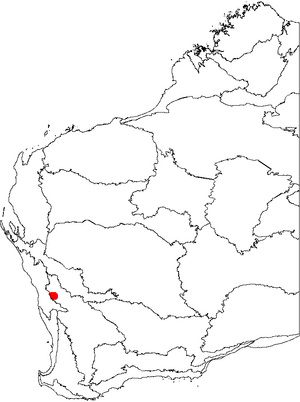Banksia trifontinalis facts for kids
Quick facts for kids Banksia trifontinalis |
|
|---|---|
| Conservation status | |
| Scientific classification | |
| Genus: |
Banksia
|
| Species: |
trifontinalis
|
| Synonyms | |
|
Dryandra trifontinalis A.S.George |
|
Banksia trifontinalis is a type of shrub that grows in the southwest of Western Australia. It's special because it only grows there, which means it's endemic. This plant has long, thin leaves with jagged edges and sharp points. It also has pretty pale yellow flowers that grow in clusters of about sixty. After the flowers, it produces small, oval-shaped fruits called follicles.
Contents
What Does Banksia trifontinalis Look Like?
Banksia trifontinalis is a shrub that branches out a lot. It usually grows up to about 2 meters (6.5 feet) tall. Unlike some other plants, it doesn't have a special woody base called a lignotuber that helps it regrow after a fire.
Its leaves are long and thin, measuring between 30 and 160 millimeters (1.2 to 6.3 inches) long and 10 to 18 millimeters (0.4 to 0.7 inches) wide. They can be directly attached to the stem or have a short stalk up to 10 millimeters long. Each side of the leaf has five to ten sharp, triangular teeth.
The flowers are a pale yellow color and grow in round clusters. Each cluster has about 55 to 65 flowers. At the base of these flower clusters are small, egg-shaped or spear-shaped leaves called bracts, which are up to 10 millimeters long. The main part of the flower, called the perianth, is about 24 to 25 millimeters long. The female part of the flower, the pistil, is about 25 to 26 millimeters long and mostly straight.
This plant flowers from August to September. After flowering, it produces small, slightly hairy fruits called follicles. These fruits are oblong or egg-shaped and are about 6 to 9 millimeters long.
How Banksia trifontinalis Got Its Name
The first time this plant was officially described was in 1996. A scientist named Alex George collected a sample of it near Three Springs, Western Australia in 1986. He then wrote about it in a science journal called Nuytsia.
When he first described it, he named it Dryandra trifontinalis. The name trifontinalis comes from two Latin words: tri- which means "three," and fontinalis which means "of a spring." This name was chosen because the plant was found near the town of Three Springs.
Later, in 2007, two other scientists, Austin Mast and Kevin Thiele, studied all the plants in the Dryandra group. They decided that all Dryandra species should actually be part of the Banksia group. So, Dryandra trifontinalis was officially renamed Banksia trifontinalis.
Where Banksia trifontinalis Lives
Banksia trifontinalis is found in only a few places in Western Australia. You can find it near the towns of Arrino and Three Springs. This area is part of a larger region known as the Geraldton Sandplains.
This plant likes to grow in a specific type of soil called lateritic soil. It's often found in low woodlands, which are areas with scattered trees. Even though it's only in a few spots, it can be quite common in those specific locations.
Protecting Banksia trifontinalis
The Government of Western Australia's Department of Parks and Wildlife keeps track of plants like Banksia trifontinalis. They have classified it as "Priority Three".
What does "Priority Three" mean? It means that scientists don't know a lot about this plant, and it's only found in a few places. However, it's not currently in immediate danger of disappearing. This classification helps make sure that people are aware of the plant and can keep an eye on its populations to protect it for the future.



